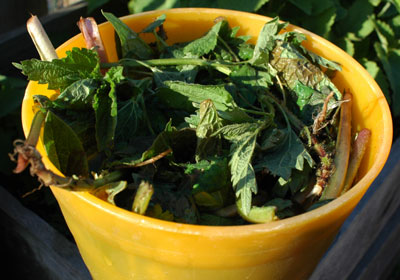Make Herb Tea Fertilizer
Did you know you can make liquid fertilizer for your plants using other plants? Sounds like floral cannibalism but it’s not unlike compost when you think about it. Some plants are high in particular nutrients which can be extracted in the same way that you would make a medicinal tea for yourself. What’s more, all of the plants worth using tend to be invasive in the garden. This year your eyes will light up with enthusiasm at the sight of that ever-expanding patch of comfrey behind the shed instead of glazing over with the thought of digging it up. Hell, I am completely jealous of your expanding comfrey patch. Yeah, come to think of it, I’ll take your shed too.
-
1. Fill up a bucket, large jar, or other container with the leaves, stems and flowers of pruned herbs. Pack them in tightly. There is no need to remove the entire plant. Just cut it back and you’ll be able to make another batch next month.
2. Pour in water, filling your container to the top.
3. Let the whole mess sit for a day. Put it in the sun to speed things up.
4. Strain out the herbs and fill up a spray bottle or watering can with the concoction.
You can spray the leaves of your plants with this mix as a foliar fertilizer, or just pour it onto the soil.
- Herbs to Try:
- Comfrey – High in magnesium, phosphorous, and pottassium.
- Stinging Nettle – Contains magnesium, sulphur, and iron.
- Horsetail – Loaded with silica, a nutrient that makes plants strong.

My tea contains comfrey and stinging nettle (watch those stingers!).
Are you joking? Horsetail? I’m starting a fertilizer business today!
I used comfrey leaves as mulch around my new rose bush last year – it worked like a charm. I’m going to get organized and make comfrey tea this year, so thanks for the inspiration Gayla.
any kind of herb plant is okay?
are there any NOT to use?
Great tutorial! I’ve been looking for a stinging nettle source for a while now – where did you find yours?
Hanna: Not every herb plant has the nutritional content you would want. There are a few others but I would stick with the comfrey, horsetail, or nettle
Sophie: Don’t know where you are located but stinging nettle grows wildly and abundantly in fallow places.
like emira, i’m definitely not lacking in horsetail – i will definitely try this out.
Stinging nettle tea is excellent for humans too!
Hey! This is wonderful, I was just bugging our head gardener where I work about which teas he would recommend and these were the three. I love “boiling down” the tea options to just three plants, it makes it a lot easier to incorporate into ones own garden.
Speaking of useful invasive plants, I feel a kindness toward Sweet Woodruff… I just make a LOT of May Wine. One must do what one has to do…
Horsetail!
Well, hey, I’m glad it’s good for SOMETHING!
Dandelion and plantain and dock plants (usually plentiful) also make great liquid compost. I keep buckets in the garden, adding water and more plants regularly.
hello kacey here, i was just wondering how do nettles leave marks when you have been stung or prikled and why do they sometimes leave lumps please answer thanks.
Nettles sting because of its’ chemical constituents… there are a few different chemicals involved including histamine and acetylcholine. The plant is covered in tiny, hollow prickles that deliver the chemicals through your skin.
My skin gets painfully red and itchy from touching the plant but I have never experienced lumps. Some people are more sensitive to the chemical sting than others.
Kacey… I used to get the bumps when I was younger. That’s just where the plant pricked your skin. The bumps usually go away after a day or so. I happened upon stinging nettle in my garden and didn’t realize it until I had touched one of the leaves to the back of my thumb. No bumps this time, just lots of tingling the rest of the day.